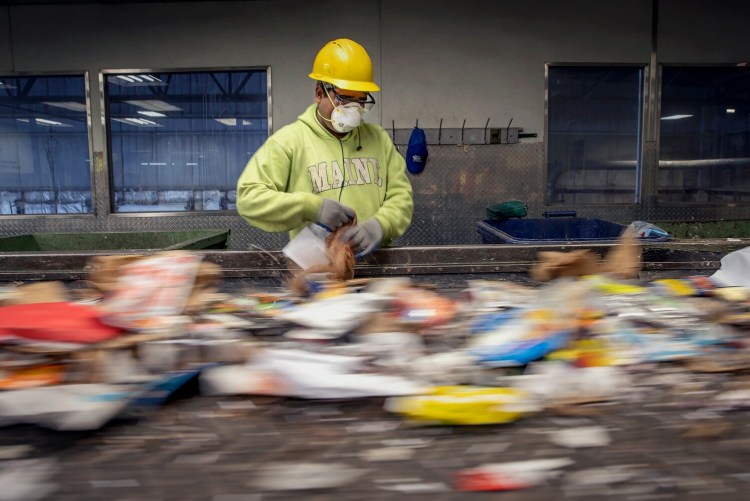The value of household paper, cardboard, plastic and metal skyrocketed over the last year, setting Maine’s recycling industry on steady footing after years of losing money in a slumping commodities market.
Prices soared as new U.S. mills came online to process recycled waste into new products at the same time demand surged during the pandemic for products such as toilet paper and packaging material and prices rose for some “virgin” materials. Some analysts think the recent boom could be a course-correction after a prolonged market downturn blamed on China’s ban on most recycling imports three years ago.
“The value for every commodity has increased,” said ecomaine spokesman Matt Grondin. “Across the board, paper, cardboard, all the plastics and both metals are up fairly significantly over the last 12 months.”
The soaring value of mixed paper – a combination of magazines, junk mail, office paper and paperboard packaging – shows the magnitude of the changing market.
Last July, ecomaine was losing $27 dollars on every ton of mixed paper that came through its loading docks. That same ton was worth $56 a year later, a three-fold increase.
The value of mixed paper is critical because it represents the single biggest type of recycling ecomaine handles, making up about one-third of all materials.
Other materials have gained, too. The value of all types of recyclable plastic rose, with the price for #2 HDPE colored – the plastic in milk and detergent jugs – jumping more than tenfold, from $100 a ton last July to almost $1,300 a year later.
Corrugated cardboard almost tripled, from $51 a ton to $146. Aluminum went from $722 to $1,188 a ton.
Low-value materials such as paper were hammered three years ago when China – then America’s largest export market for waste – put tight restrictions on the type and quality of recycling it accepted. The trade barrier sent the value of some commodities tumbling and passed the costs onto local communities used to subsidizing household recycling programs with money earned from selling recyclables.
With rising recycling costs, some communities in Maine and across the country cut back or eliminated municipal recycling programs.
Ecomaine kept its program intact, but pressed its 48 communities to reduce contamination of the recycling stream – material that was too dirty or combined with non-recyclables would not sell. In 2018, ecomaine’s recycling was about 18 percent contaminated, Grondin said. These days, it is between 10-12 percent contaminated.
“It is to the benefit of companies like ecomaine who stayed in the recycling game; who continued their programs these challenging years,” Grondin said. “(We can) see the benefits of improving markets instead of hopping in and out and trying to restart a program people may not have used in the past three years.”
American fiber mills upgraded to take more mixed paper and other commodities locked out of China, and other international markets soaked up some exports, said Bret Biggers, senior economist at Institute of Scrap Recycling Industries, a trade group. Rising costs of “virgin” petroleum, wood and other materials also have increased demand for recyclable goods, he said.
RECYCLABLES IN DEMAND
As a result, recyclables were in demand to make products such as toilet paper and packaging material, as well as other consumer goods such as cars, bikes and plastic containers.
Broader economic pressures, such as shipping and transportation bottlenecks, a shortage of labor and other supply chain disruptions also have affected the recycling industry as the U.S. economy goes through a growth spurt. “When there is lower supply compared to demand, prices rise,” Biggers said.
Even if recycling prices are high now, they might not stay that way. Commodity values respond to market demand, which leaves taxpayers on the hook to pay for recycling programs when prices inevitably dip, said Sarah Nichols, Sustainable Maine Director at the Natural Resources Council of Maine.
This summer, Maine passed one of the first laws in the nation that forces private companies to pay for disposing of wasteful packaging and encourage the development of materials that are easier to recycle. That kind of product stewardship program, now under rulemaking by the state environmental protection department, could protect communities from market shocks such as China’s recycling policy, Nichols said.
“When that happened, it really disrupted recycling programs in the United States because towns and cities found themselves paying more for recycling than they had budgeted for,” Nichols said.
In neighboring Quebec, where producers are responsible for packaging materials, “nothing changed for their residents because there was funding available from the stewardship organization to keep things going until the markets got better,” Nichols said.
Send questions/comments to the editors.




Comments are no longer available on this story